Chains
Problem:
A rope of length l slides over the edge of a table. Initially a piece x0
of it hangs without motion over the side of the table. Let x be the length of
rope hanging vertically at time t. The rope is assumed to be perfectly
flexible.
Show that E = T + U is a constant of motion.
Solution:
- Concepts:
Conservation of mechanical energy
- Reasoning:
We are asked to show that the mechanical energy is conserved in a given
situation.
- Why do we expect mechanical energy to be conserved in this
situation?
The only external forces acting are gravity on the vertical part of the
rope and the normal force and gravity on the horizontal part of the
rope. Gravity is a conservative force and the normal force acts
perpendicular to the velocity and therefore does no work.
- Details of the calculation:
Let l be the length of the rope, ρ its mass per unit length, and let x be
the part hanging over the edge.
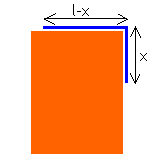
This is an effectively one-dimensional problem. The picture below shows a
blow-up of the corner, the section of the rope bending around the corner has
infinitesimal length.
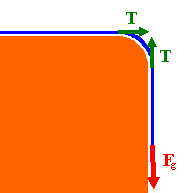
Fg - T = d(ρxv)/dt for the vertical part of the rope, T =
d(ρ(l-x)v)/dt for the horizontal part of the rope.
Defining p = ρlv = ρldx/dt we have Fg = dp/dt = ρld2x/dt2
= ρgx.
d2x/dt2 = gx/l.
T = ½ρl(dx/dt)2, U = -ρg(x2/2), E = T + U =
½ρl(dx/dt)2 - ρg(x2/2)
dE/dt = ρl(dx/dt)d2x/dt2 - ρgxdx/dt = ρgxdx/dt - ρgxdx/dt
= 0.
Problem:
A chain lies pushed together at the edge of a table, except for a piece which
hangs over it, initially at rest. The links of the chain start moving, one at a
time.
Show that E = T + U is not a constant of motion.
Solution:
- Concepts:
Non-conservation of mechanical energy in inelastic
processes
- Reasoning:
We are asked to show that the mechanical energy is not conserved in a given
situation.
- Why do we expect mechanical energy to not be conserved in this
situation?
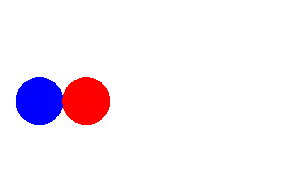
Consider two adjacent links of the chain. Link 1 (red) moves away from
link 2 (blue). Initially the two links do not interact. After link 1
has traveled a distance Δx, it interacts with link 2 (blue) and the two
links stick together and move together. The two links "collide"
inelastically. In an inelastic collision mechanical energy is not
conserved.
- Details of the calculation:
Let ρ its mass per unit length of the chain. Let l be the length of the
chain that hangs over the edge. This part of the chain is moving. Let the
x-axis point downward and let the tabletop be at x = 0.
px = ρlv = ρldl/dt. Fx = dpx/dt = ρ(dl/dt)2
+ ρld2l/dt2 = ρlg.
T = ½ρlv2 = ½ρl(dl/dt)2, U = -ρlg(l/2),
E = T + U = (ρl/2)[(dl/dt)2 - gl].
dE/dt = (ρ/2)(dl/dt)3 + ρl(dl/dt)d2l/dt2 -
ρgldl/dt.
d2l/dt2 = g - (1/l)(dl/dt)2, from Fx
= dpx/dt.
dE/dt = (ρ/2)(dl/dt)3 + ρlg(dl/dt) - ρ(dl/dt)3- ρgldl/dt
= -(ρ/2)(dl/dt)3 = -(ρ/2)v3 ≠ 0.
Problem:
A butcher is holding a long string of small-link sausages upright just above
the scale pan. She offers to charge the costumer for just ½ of the maximum
reading of the scale after she releases the string. The customer eagerly
agrees. What percentage of the regular charge does the customer pay?
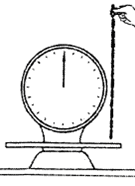
Solution:
- Concepts:
Newton's 2nd law, F = dp/dt
- Reasoning:
Let the mass of the string of sausages be m, its length be
L, and let λ = m/L. Consider the string to consist of sections of length
dx. After the string has fallen a distance x, the sections that have not
yet reached the table have velocity v = (2gx)½. The scale has
to support a section of the string of length x and has to reduce the
momentum of a section of length dx from λdxv to zero in a time interval dt.
- Details of the calculation:
The scale has to exert a force F = λxg +
λv2 in the upward direction.
F = λxg + λ2gx = 3λxg.
The
maximum force is exerted when the last link is stopped by the scale. Fmax
= 3λLg = 3mg.
½Fmax = 1.5 mg. The customer pays 150% of the
regular charge.
Problem:
A uniform, dense rope of length b and mass per unit length m is
coiled on a smooth table. You lift one end of the rope by hand vertically
upward at constant speed u0. Find the force that you must apply
to the rope when the end is a distance a above the table (a < b).
Solution:
- Concept:
Newton's 2nd law, F = dp/dt
- Reasoning:
Let a be the distance of the end of the rope above the
table. Consider the rope to consist of sections of length dx. To move the
rope upward with constant speed, you must apply an upward force equal to the
force of gravity on the section of length a in addition to a force to change
the momentum of a section dx from 0 to mdxu0 in a time interval
dt.
- Details of the calculation:
F = mag + m(dx/dt)u0 = mag +
mu02.
Problem:
A uniform heavy chain of mass λ per unit length hangs vertically so that the
low end just touches a horizontal table. The upper end is released and the
chain falls on the table. Find the force the chain exerts on the table
after it has fallen a distance x.
Solution:
- Concepts:
Impulsive forces, Newton's 2nd law, F
= dp/dt
- Reasoning:
Consider the chain to consist of sections of length dx. After the chain has
fallen a distance x, the sections that have not yet reached the table have
velocity v = (2gx)½.
The table has to support a section of the chain of length x and has to
reduce the momentum of a section of length dx from λdxv to zero in a time
interval dt.
- Details of the calculation:
The table has to exert a force F = λxg + λv2 in the upward
direction.
F = λxg + λ2gx = 3λxg.
Problem:
A rope of mass M and length L is suspended in the earth's gravitational
field, g, with the bottom end of the rope touching a surface. The rope is
released from rest and falls limply on the surface, without bouncing. Find
the force F(t) exerted on the surface as a function of time. At what time
does F(t) reach its maximum? What is the magnitude of this maximum force?
Solution:
- Concepts:
Newton's 2nd law, F = dp/dt
- Reasoning:
Let λ = M/L. Consider the
rope to consist of sections of length dx. After the rope has fallen a distance x
= ½gt2, the sections that have not
yet reached the table have velocity v = (2gx)½. The scale has
to support a section of the rope of length x and has to reduce the
momentum of a section of length dx from λdxv to zero in a time interval dt.
- Details of the calculation:
The scale has to exert a force F = λxg +
λv2 in the upward direction.
F = λxg + λ2gx = 3λxg. F(t)
= (3/2)(M/L)g2t2 for t < T = (2L/g)½.
The
maximum force is exerted when the last link is stopped by the scale. Fmax
= 3λLg = 3Mg at t = T.
For t > T we have F = Mg.
Problem:
A rope with mass M and length L is held in the position shown below, with one
end attached to a support. (Assume that only a negligible length of the rope
starts out below the support.) The rope is released. Find the force that the
support applies to the rope, as a function of time.
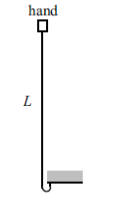
Solution:
- Concepts:
Newton's second law
- Reasoning:
At time t, the free end of the rope is moving at speed gt, and it has fallen a
distance gt2/2. This distance gets "doubled up" below the support.
So at time t, a length gt2/4 is hanging at rest, and a length L - gt2/4
is moving at speed gt. The momentum of the entire rope is therefore p = - λ(L -
gt2/4 )gt, where λ is the mass per unit length of the rope. The
minus sign signifies downward motion. The forces on the entire rope are Mg =
λLg downward, and N (the force from the support) upward.
- Details of the calculation:
F = dp/dt applied to the entire rope gives
N - λLg = d/dt(- λ(L - gt2/4 )gt) = - λLg + 3λg2t2/4.
N = 3λg2t2/4.
or:
N must support a section of length a length x = gt2/4 and must change
the momentum of a section dx = 2gtdt/4 from λdxgt to zero. dp = 2λg2t2dt/4,
dp/dt = 2λg2t2/4.
N = λg2t2/4 + 2λg2t2/4 = 3λg2t2/4.
Problem:
A chain with mass/length = m hanging vertically from one end, where an upward
force F is applied to it, is lowered onto a table as shown in the figure.
Find the equation of motion for h, the height of the end above the table (h is
the length of chain hanging freely).
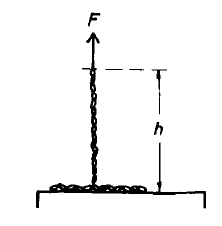
Solution:
- Concepts:
Newton's 2nd law, F = dp/dt
- Reasoning:
In addition to the applied and gravitational forces, we
have to take into account the impulse due to a section of the chain being
stopped by the table.
- Details of the calculation:
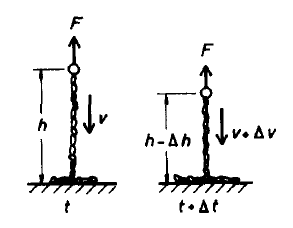
For
this one-dimensional problem let the downward direction be the positive
direction.
The change in momentum of the chain in a time interval dt is
dp = m(h - dh)(v + dv) - mhv = m h dv - m dh v,
keeping only first
order terms.
dp/dt = m h dv/dt - m dh/dt v = m h dv/dt - m v2,
We also have
dp = -Fdt + m h g dt - m dh v, where mdhv is the impulse
due to a section of the chain being stopped by the table. This impulse is
provided by the normal force from the table.
dp/dt = -F + mhg - m v2.
Combining: dv/dt = -(F - mhg)/(mh). dv/dt = -d2h/dt2.
d2h/dt2 = F/(mh) - g.
Problem:
A ball of mass M on a frictionless horizontal table is pulled by a constant
horizontal force F. A coiled up rope of mass per unit length r is attached
which uncoils as the body moves.
(a) By taking into account the
uncoiling of the rope, derive an expression for the speed of the ball as a
function of distance traveled.
(b) Evaluate the terminal speed of the
ball, assuming a very long rope.
Solution:
- Concepts:
Newton's 2nd law, F = dp/dt
- Reasoning:
F = dp/dt, yields the equations of motion,
which can be solved for the velocity as a function of position.
- Details of the calculation:
(a) F = dp/dt. (1-dimensional problem)
p = mv = (M + mrope)v, dp = vdmrope + mdv. dmrope
= rdx, m = M + rx.
F = rv2 + (M + rx)dv/dt.
We are
interested in dv/dx.
dv/dt = (dv/dx)v. vdv/dx = (F - rv2)/ (M
+ rx).
Let x' = (M + rx), then dx' = rdx.
vdv/dx' = (F/r- v2)/x'.
Let F/r = B.
vdv/dx' = (B - v2)/x', dv2/dx' = 2B/x'
- 2v2/x' = 2(B - v2)/x'.
Let v'2 = -v2.
Then dv'2/dx' = -2v'2/x'.
v'2 = C1/x'2.
dv'2/dx' = -2C1/x'3 = -2v'2/x'.
v2 = F/r - C1/x'2.
The initial
conditions are v2 = 0 and x' = M.
Therefore C1 = M2
F/r.
v2(x) = (F/r)(1 - M2/(M + rx)2).
(b) As x--> infinity, v2 --> F/r.
Problem:
A uniform chain of length 4l and mass density ρ is held so half of it is
coiled up in a heap at the edge of a smooth table while the other half is
hanging as shown. It is supported at a point A, which is at the same
vertical height as the table.

The chain is released from rest.
(a) Show that just after the last
link leaves the table its speed is v = (31/20)½(gl)½.
You may assume
that all motion occurs along a single vertical line.
(b) What force is
exerted on the chain at point A, immediately prior to the instant when the chain
first becomes vertical?
Solution:
- Concepts:
Newton's 2nd law
- Reasoning:
The system consists of the part of the chain that is
coiled up, the part that is falling, and the part that is hanging at rest.
In a small time interval dt the momentum of the system changes because a
small amount dm1 of the coiled up chain receives an impulse dm1v
and starts falling, a small amount of the falling chain dm2
receives an impulse -dm2v and stops falling and the section m
that is falling speeds up (mdv). The forces acting on the uncoiled parts of
the chain are gravity and the force from the support.
- Details of the calculation:
(a) Δp = (m + Δm)(v + Δv) - mv, dp =
mdv + vdm.
- Let us picture each link of the chain
as a box.
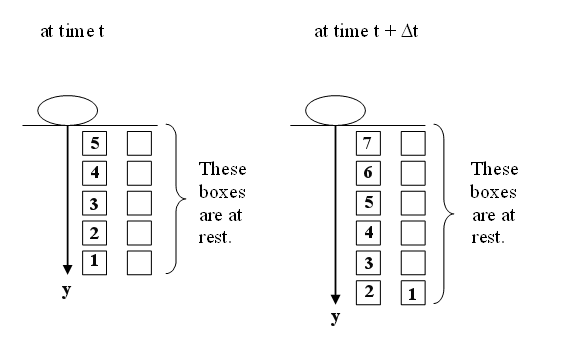
At time t: p = ρyv.
dp = ρydv/dt + vρdy.
dp/dt =
ρy(dv/dt) + ρv(dy/dt). dy/dt = v/2.
The falling links travel a distance
equal to the length of two links while the length of the chain y only
increases by the length of one link.
The force on the part of the chain
that is not coiled up is
F = 2ρyg - Fs (gravity + force from the
support).
Let Fs = F1 + ρyg. F1
provides the impulse that stops dm2.
F1 =
ρ(dy/dt)v = ρv2/2.
F = dp/dt = ρyg - F1. ρy(dv/dt)
+ ρv2/2 = ρyg - ρv2/2. ydv/dt + v2 = yg.
We want to solve this differential equation for v(y). We want to find
v(2l). We have to eliminate t from the equation.
dy/dt = v/2. d/dt =
(v/2)d/dy. y(v/2)dv/dy + v2 = yg. (y/4)dv2/dy + v2
= gy.
dv2/dy = -4v2/y + 4g.
Try v2 =
ay + b/y4. Then dv2/dy = a - 4b/y5 = -4v2/y
+ 5a. Therefore a = 4g/5.
v2(l) = 0 --> al + b/l4
= 0, b = -al5.
v2(2l) = a2l - al5/(16l4)
= al(2 - 1/16) = al*31/16 = gl*31/20.
(b) Assume the last link has
left the table. Look at the chain at some time t when a section is falling
and a section is hanging at rest.
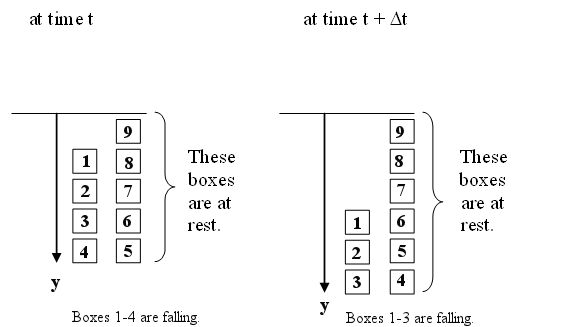
p = ρ(y - y1)v, dp = mdv
+ vdm = ρ(y - y1)dv + ρv(dy - dy1)
dp/dt = ρvdy/dt - ρvdy1/dt + ρ(y - y1)dv/dt.
dy/dt = v/2, dy1/dt = v.
F = ρ(y - y1)g - F1
= ρ(y - y1)g - ρv2/2.
F = dp/dt --> ρ(y - y1)g
- ρv2/2 = -ρv2/2 + ρ(y - y1)dv/dt.
dv/dt = g, dy/dt = v/2, (v/2)dv/dy = g, dv2/dy = 4g.
v2(4l)
- v2(2l) = 4g*2l = 8gl.
v2(4l) = gl*31/20 + 8gl =
191/20.
F1(4l) = ρv2(2l)/2 = ρgl*191/40.
Fs
= ρ4gl + ρgl*191/40 = ρgl*351/40 = total force exerted by the support.









